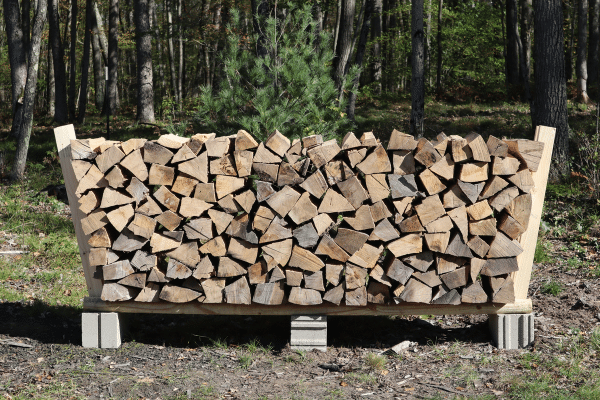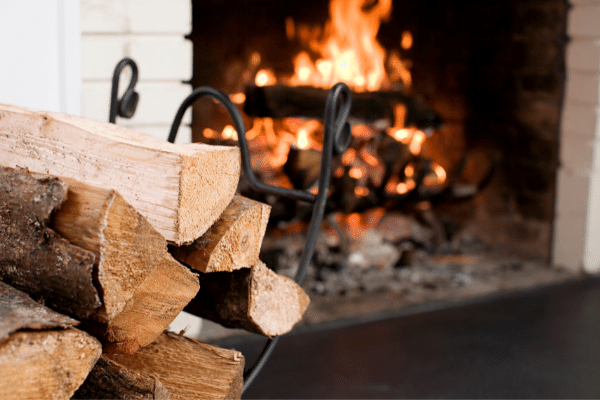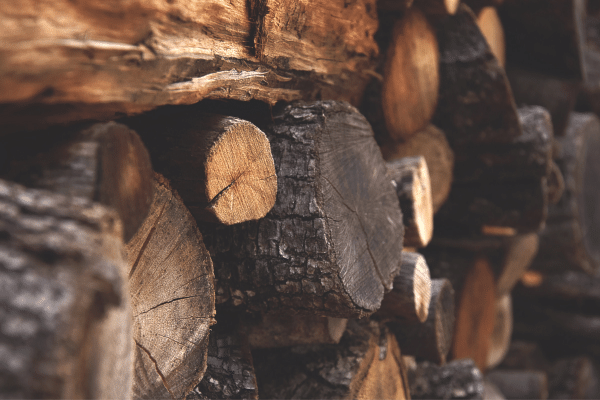- Home
- Types Of Firewood
- How to Stack Firewood
How To Stack Firewood
This post may contain affiliate links so I earn a commission.
If you want to learn how to stack firewood so it's dry, won't create a lot of smoke, and is easy to light, you've come to the right place!
Whether you're looking to save money on your winter utility bills by heating with wood, or you simply want to enjoy a handful of relaxing summer evenings by a campfire, having a supply of dry firewood is important.
Wet wood that hasn't been properly stored and allowed to dry simply doesn't burn.
Also called green firewood, this wet wood will leave behind creosote inside your chimney, or if you're tying to enjoy a campfire, it will just create so much smoke you won't be able to appreciate the fire.
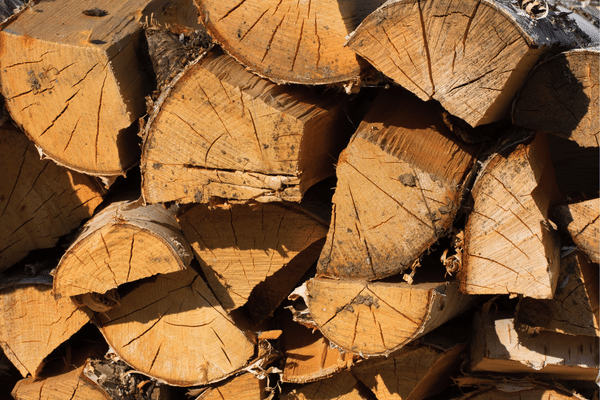
So what's the secret to a perfect fire?
Dry firewood.....and dry firewood starts with proper storage!
To learn more, check out these 6 simple, yet very effective ways to stack firewood so it's dry and ready to burn when you need it.
Tips For Stacking Firewood
Although stacking some firewood into a row sounds easy, there's a few tricks to consider so the wood dries quickly and doesn't rot.
When stacking your firewood, consider these important tips:
- Elevate your firewood off the ground using pallets, 2x4 runners, or long branches. This allows the air to flow around the entire stack of wood and it stops the bottom row of wood from soaking up ground moisture which can cause rot and decay.
- Cover the top 1/3 portion of the firewood stack to repel rain and snow if you don't have a shelter. It's important not to cover the entire stack because the wood needs to "breathe" and you need to let the moisture escape so it doesn't cause the wood to grow mold.
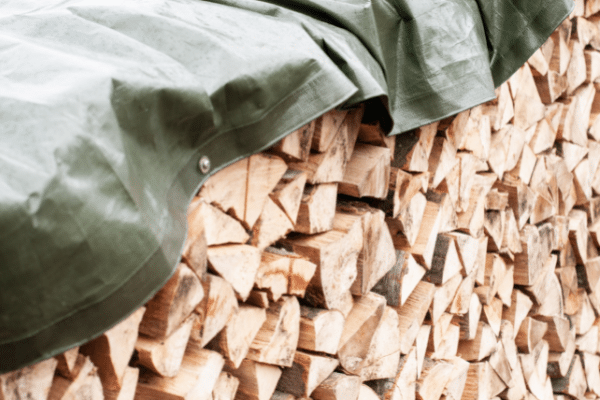
- Use square logs with flat sides to construct the end pillars of your firewood stack. These square pieces are uniform in shape and work perfect for the end columns.
- No matter which stacking method you use, make sure your stack is level and don't stack the wood taller than 4 feet. An uneven stack of firewood, or a row that is too tall will easily fall over.
- Create your stack of firewood in a sunny location that is not sheltered from the wind. The warm summer sun and wind will help dry out your firewood much faster than a shady location.
How To Stack Firewood Without A Rack
A firewood rack makes stacking firewood really easy, but unfortunately not everyone has access to one.
Don't worry though, you can still create a great stack of firewood without using a firewood rack.
One of the most popular ways to stack firewood is to construct two end pillars and fill the space between the pillars with split firewood.
To begin, choose split pieces of wood that are uniform in size and fairly square for the end pillars.
To build the pillars, lay 3 pieces of wood parallel to each other for the first level.
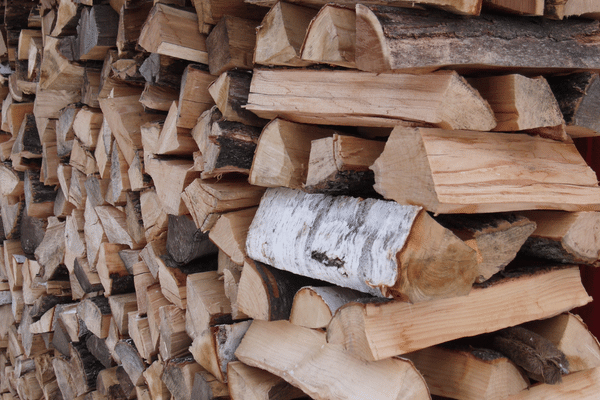
For the second level, place 3 more logs perpendicular on top of the first level.
Continue this criss-cross/alternating with the logs until your pillar is roughly 4 feet tall.
Next, you'll need to build another pillar about 8 feet away that is in line with the first pillar you built.
After the end pillars are built you can start stacking the wood between the two pillars.
I like to lay down some long branches to separate the wood from the ground, or a few 2x4's work great too.
It works best if the cut ends of the wood face the prevailing wind which helps dry out the wood even faster.
Use some of the largest pieces you have for the first row, and place the wood with the bark side down towards the ground.
I only place the first row with the bark side down to offer a layer of protection between the wood and the ground.
The rest of the wood stacked in the row should be stacked bark side up to help shed any rain or snow that comes into contact with the stacked wood.
How To Stack Firewood On Pallets
Pallets work great as a platform to stack firewood on because they offer a cheap and easy way to elevate the firewood off the ground.
Plus, if you look around you can usually find pallets for free.
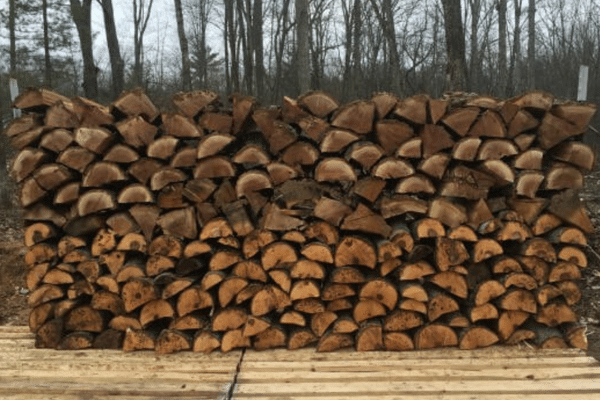
Learning how to stack firewood on pallets is really easy.
Just make sure the pallets are level, then use a couple of T-Posts on each end as a support to stack the firewood up against.
I also use pallets for the floor of my firewood shed because they work so well and they last a long time.
How To Stack Firewood In A Circle
A popular German style of stacking firewood in a circle is called the Holz Hausen, also known as a beehive stack.
This method works really well, and it looks amazing when you're finished.
Start by selecting a level piece of ground and scribe a 6' circle in the dirt to use as a template.
Choose logs that have at least one flat side and lay them in a ring around the perimeter of the circle.
Next, lay a second row of logs as shown below to start building the stack.
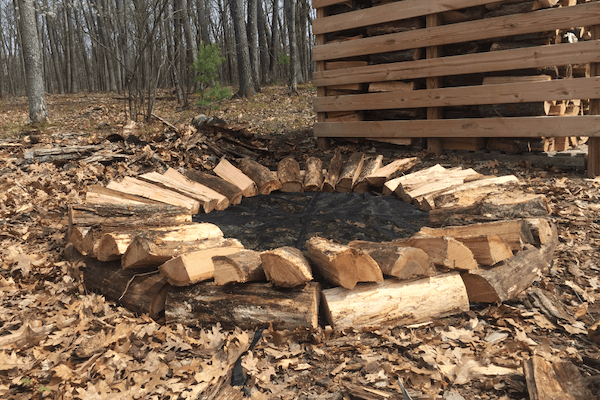
Now you just continue to build up the sides by laying more wood on top of the second row.
You want the sides to gradually slant in towards the middle.
Eventually, you'll start to loose the inward slant, so you can just make another ring of perpendicular logs like you did on the first layer.
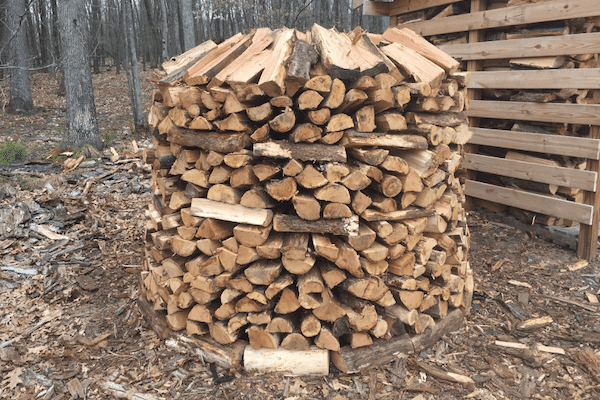
As the outside walls are built, you'll be left with an empty space inside the circle.
You can fill this empty space with random pieces of split wood.
Just throw them right into the middle, there's no need to stack them.
Finally, as the outside walls reach about 5 feet in height, you can taper the wood to form a roof and you're done!
How To Stack Firewood In A Shed
A firewood shed offers a permanent, covered storage area to stack your firewood.
Although they are the most expensive option for storing firewood, they're the best.
If you heat with firewood throughout the winter, I highly recommend building a firewood shed to store your wood.
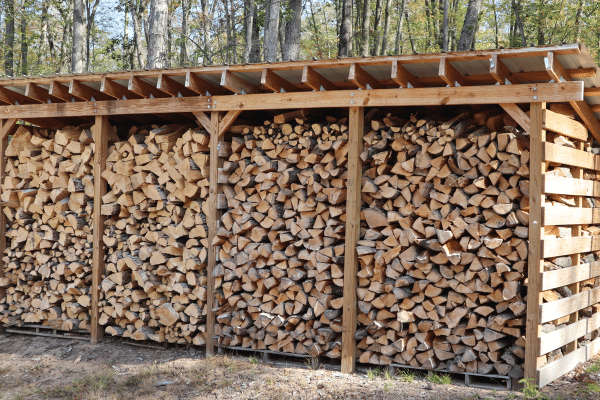
As you can see in the photo above, I used steel sheeting for the roof and pallets for the floor.
This elevates the wood off the ground and protects the wood from rain and snow.
Also, the sides of the firewood shed are slatted to allow wind to blow through the wood and help dry it out faster.
How To Stack Firewood On A Hill
If you don't have a flat piece of land to stack wood on, you can stack firewood on a hill by using cement blocks as a shim.
It's always best to try and flatten out the ground with a shovel, but if you have a 8"-10" slope, you can use logs or cement blocks under pallets or 2x4's to create a level base.
For example, you can set one end of the pallet on the ground, then on the slopped end, simply place a few cement blocks under it to fill the gap and make the pallet level.
How To Stack Firewood So It Doesn't Rot
Learning how to stack firewood so it doesn't rot is pretty easy.
Like we've mentioned several times before, you need to elevate the wood off the ground to prevent contact with the ground.
If you don't elevate the wood, it will soak up ground moisture and start to rot.
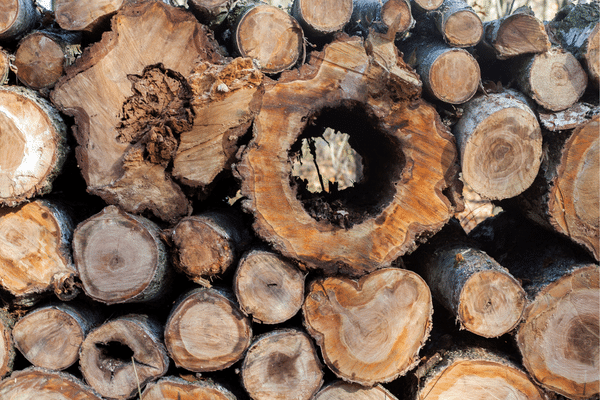
Also, you'll need to cover the top of the firewood stack with a tarp, or other similar device
Old metal roofing works great too!
Just make sure you only cover up the top portion of the firewood stack so the rest of the wood can breathe and evaporate all of the moisture from inside the wood.
If you elevate the wood, cover the top and stack it in a sunny location, you can store firewood for several years before you have to worry about it starting to rot.
Stacking Firewood With The Bark Up Or Bark Down?
There's a long running debate over which method is better for stacking firewood......bark up or bark down.
As a general rule, if you're storing firewood outside and not in a wood shed, you should stack the firewood with the bark side up.
With the bark on the topside of the wood, it helps shed rain and snow.
If you stack the wood with the bark side down, there are concerns that water can get trapped in the trough created between the bark and the wood, delaying the drying process.
If you're stacking firewood inside of a wood shed, it really doesn't matter which direction the bark faces.
How To Stack Firewood - Overall
When learning how to stack firewood, there's a lot of different ways that are very effective.
No matter which method you choose, stack your firewood correctly the first time and you'll enjoy dry, great burning firewood in the future.
